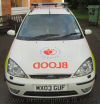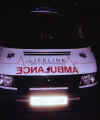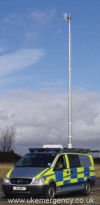Category: OTHERS
MX03 GUF This Ford Focus TDCi estate is used …

MX03 GUF This Ford Focus TDCi estate is used for the urgent transportation of blood by the National Blood Service.
The front view. Notice the slim blue light bar and the blue strobe light next to the rear view mirror. You can also see the roof markings stating ‘urgent blood’.
The side view of the same car. The NBS originally had a wide blue stripe down the sides of their vehicles (both emergency, and non-emergency), examples of which can be seen in other blood service pages. More recently, they have adopted a (very appropriate) wide red stripe. This rapid deployment vehicle has a third livery of red and yellow battenburg, which is similar in appearance to some fire service cars.
The rear and nearside views. The ‘phone number, website address and ‘NHS’ logo can all be seen.
P86 YJR is not a blood service vehicle, but …

P86 YJR is not a blood service vehicle, but it does do a similar job. This ambulance is used solely for the transportation of human organs. The drivers are on call to respond to organ transportation emergencies. There may be a liver at ‘A’ wanted by a patient at ‘B’; and it’s life span outside of a human body is severely limited.
This is a smaller Mercedes Vito van which …

This is a smaller Mercedes Vito van which serves the same purpose. Notice the defunct telephone number starting ‘0345’.
E1 AWV on field trials with its …

E1 AWV This Mercedes Vito has been converted to an Emergency Response Vehicle for communications at a major emergency on the London Underground. Three such vehicles are kept in secure garages and can respond with 30 minutes notice. They are run by the company O2 as they operate the Airwave service.
The side view of the same vehicle. It is fitted with blue lights and another obvious addition is the telescopic mast protruding from the roof (with the top covered by a bag). A small amount of advertising for the company that run it can be seen along the side skirt. Inside is an array of communications equipment, including 1km of cabling, that can allow radios to work underground.
The final version of the van on field trials with its telescopic antenna partially erect.











